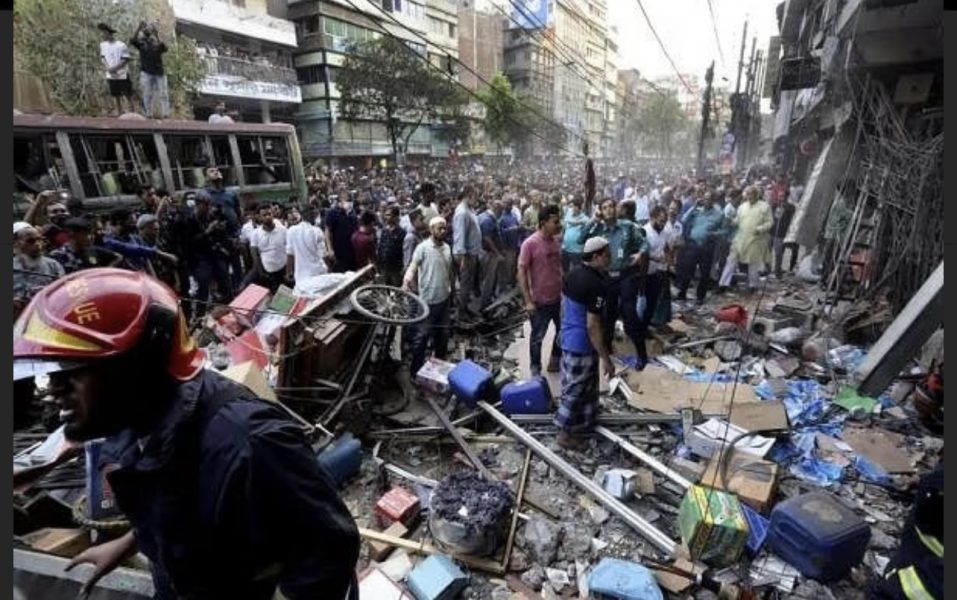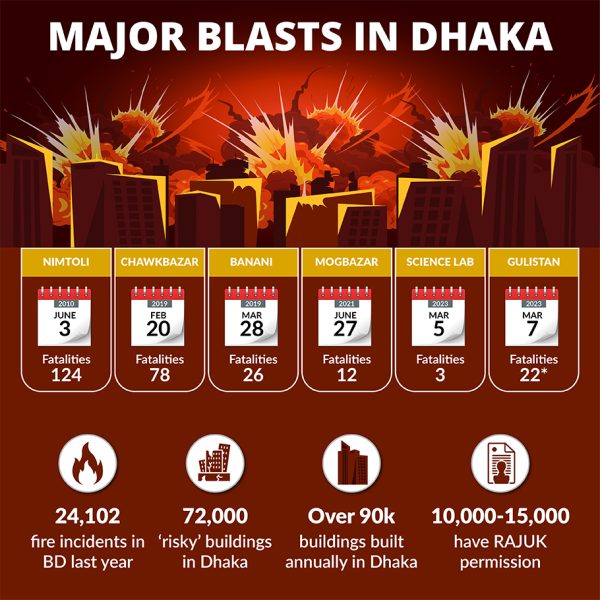
Dhaka blasts: How a city of 22 million people is ‘a ticking time bomb’

Two as-yet-unexplained powerful explosions at commercial buildings in Bangladesh’s capital Dhaka have raised alarms about the safety of buildings crammed into one of the most densely populated cities in the world.
At least 25 people have been killed in the two explosions. The latest one in Gulistan’s Siddique Bazar was the deadlier of the two, claiming at least 22 lives so far and injuring scores of others.
But the curious thing about the explosions on March 5 and 7 is their nature. There was no trace of explosives or signs of sabotage or gas pipeline leak in both instances, leading experts to suspect another probable culprit — methane gas accumulating from sewerage line. But there has been no conclusive evidence of this either.
It could take months to learn the real cause but the incidents have again put the spotlight on poor safety management and poorer supervision by the authorities concerned, exposing millions of people to avoidable risks.
‘Ticking time bomb’
Urban planners and engineers say the two explosions in Dhaka’s busy Science Laboratory area on March 5 and the one in Siddique Bazar have made it clear that no one is safe in the megacity of 22 million people.
Also read: At least 14 dead, over 100 injured in Dhaka building explosion
Explosions and fires triggered by gas leak and electric malfunction are common in Dhaka but the Science Laboratory and Gulistan explosions exposed a far severe danger.
Both buildings are believed to be several decades old and the blasts are suspected to have occurred in the basements. Last year, the Fire Service and Civil Defence reported 24,102 fire incidents across the country, with 91 of them starting from the basement for various reasons.

A 2009 study by the Comprehensive Disaster Management Programme (CDMP) estimated that there were at least 72,000 ‘risky’ buildings in the capital susceptible to accidents.
“Dhaka’s development authority Rajdhani Unnayan Kartripakkha (RAJUK) issues permits for 10,000 to 15,000 buildings every year on average but more than 90,000 new buildings are constructed annually,” Fire Service’s chief Brig Gen Md Main Uddin told the media after the Science Laboratory blast. Most of these structures are erected, ignoring the buildings code and they lack safety measures.
“Dhaka is now like a ticking time bomb,” urban planner Iqbal Habib told Somoy Television. He explained that gas pipelines are spread under the city like a cobweb which is not often repaired, making them prone to leak that could lead to deadly explosions.
‘Like gas chambers’
Law enforcement and top government officials have ruled out sabotage in both 5 and 7 March explosions. The Titas Gas Distribution Company Ltd has dismissed claims that there were leaks in its supply pipes which could have triggered the blasts.
Two days after the Science Laboratory blast, Brig Gen Main told the media that they believed the “colossal explosion happened due to the gas that has been accumulated inside the building over a long period”.
Rahmat Ullah Chowdhury, the in-charge of Dhaka Metropolitan Police’s Counter-Terrorism and Transnational Crime’s Bomb Disposal Unit, concurred. He separately told the media that the scale of the explosion suggests that it was caused by accumulated gas and noted that the gas could have accumulated from any concealed gas pipeline “or the sewerage system”.
Also read: Wary Delhi watching Dhaka as trouble brews for Sheikh Hasina govt
Elite police unit Rapid Action Battalion’s bomb disposal unit chief Major Mashiur Rahman made a similar observation about the Gulistan blast. He said they suspect that accumulated gas in the basement might be behind the explosion.
“It was not a normal incident. Gas accumulated in the basement might have caused the explosion,” he told the media, ruling out AC as the cause.
‘A city of explosions’
The blasts come barely 10 months before the country is scheduled to go to polls where Sheikh Hasina’s Awami League will seek a fourth consecutive term. The Bangladesh Nationalist Party (BNP), the second-largest political party with no MPs in the current Parliament, is looking to make a comeback.
Both parties have been using the blasts as a tool to gain political mileage ahead of the election. BNP’s Secretary General Mirza Fakhrul Islam Alamgir said the government’s failure in monitoring has turned Dhaka into “a city of explosions,” noting that public agencies tasked with ensuring safety are “heavily corrupt” and “don’t do any real work”.
A day after the Gulistan explosion, Awami League General Secretary Obaidul Quader said the recent incidents of fire and blasts were “mysterious”. “We are investigating whether the BNP has any involvement with the explosions taking place one after another,” he said.
(The writer is a Dhaka-based independent journalist)


